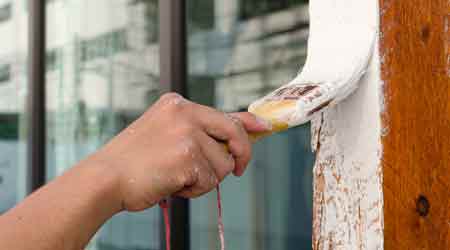Exterior Painting Project Considerations
Part 4 of a 4-part article on paints and coatings projects
Specifying the proper paint or coating for an exterior application can be more challenging than doing so for an interior application for several reasons, including changing weather, the variety of substrates, and exposure to ultraviolet (UV) rays.
The most important step when undertaking an exterior paints and coating application is to ensure proper surface preparation.
“The failure to properly clean the surface can lead to poor adhesion and ultimately a coating failure,” Kistler says. Kujawski further emphasizes the importance of proper surface preparation, describing it as the “source of 80 percent of all paint failures that I’ve seen. The exterior is a different ballgame because there’s always a side of a building exposed to weather, and with UV rays, paint will eventually chalk. If that chalk is not removed by pressure washing or by sanding, then you’re painting over chalk, and that will peel.”
Another planning issue crews must avoid is to assume that a fresh coat of paint will solve the problem of rotted wood.
“That rotted wood needs to be removed completely and replaced with fresh wood,” Kujawski says. “If there is rotting wood on the building, that usually indicates there’s a moisture problem somewhere. Moisture is getting in behind the wood and causing the wood to rot.”
Finally, to avoid the issue of faded paint after application, managers should consider specifying an acrylic paint that offers greater UV resistance for exterior paint applications.
“One common reason for repainting an exterior is to spruce up the surface due to color fade,” Burroughs says. “Fade resistance can also be largely affected by the color selection."
“When selecting color, it is important to understand the exposure of the surface to UV and ensure that the product is tinted with the most durable colorants for exterior exposure.”
Related Topics:















